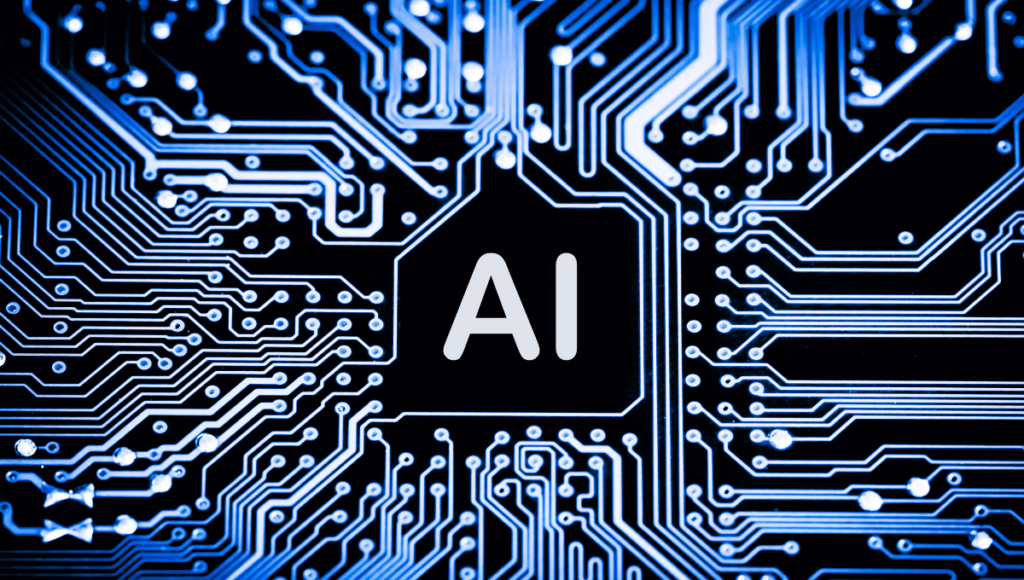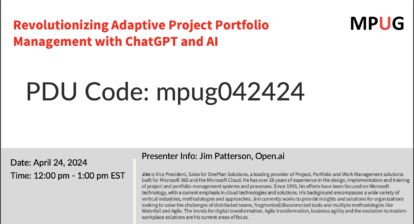
But Wait! There’s More!
In Part 1 of Effective Use of Artificial Intelligence Tools, we explained AI and its uses for predictive analysis in Project Management. But there are more than just those 8 uses for AI from our last article. In part 2, we will go a little deeper into AI with 3 more ways that AI is revolutionizing project management. Then we will explore 5 ways to ensure seamless integration for your organization.
1. Natural Language Processing (NLP)
One of the key AI applications is automating document analysis, particularly in the critical phases of requirements gathering and stakeholder communication. Traditionally, sifting through vast amounts of documentation to extract relevant requirements and communicate effectively with stakeholders has been time-consuming and prone to human error.
AI, however, can rapidly analyze documents, identify key requirements, and even highlight discrepancies or ambiguities that may lead to project scope creep. This capability accelerates the process and enhances the accuracy of requirements gathering, ensuring that projects are built on a solid foundation of clearly defined expectations. Furthermore, AI-driven document analysis can inform stakeholders by automatically generating clear and concise project updates, ensuring all parties are aligned with the project’s progress and objectives.
Another transformative use of AI in project management is enhancing team collaboration, especially through sentiment analysis and language translation. In today’s globalized work environment, project teams often span multiple countries, each with its own language and cultural nuances. AI-powered language translation breaks down these barriers, enabling seamless communication among team members, regardless of their native language. This fosters a more inclusive and collaborative team environment where ideas and feedback are freely shared and understood by all.
On the other hand, Sentiment analysis adds another layer of sophistication by gauging the tone and emotions behind the team’s communications. This technology can alert project managers to potential issues or discontent within the team, allowing for timely interventions to address concerns and maintain positive team dynamics. By leveraging AI in these ways, project management can be significantly enhanced, leading to more cohesive teams and successful project outcomes.
2. Intelligent Scheduling
The need to develop a competent schedule is not new. Advanced organizations have been using simulation tools such as Monte Carlo analysis to find the most probable schedule. Artificial Intelligence (AI) has become a pivotal ally in the realm of project management, particularly in the areas of intelligent scheduling, schedule optimization, and managing task dependencies, as well as in adapting to changes that occur during the project lifecycle.
AI technologies can process vast amounts of data at incredible speeds, enabling them to perform complex scheduling tasks that would be time-consuming and prone to error if done manually. By leveraging historical project data, AI algorithms can predict the optimal sequence of tasks, identify the best allocation of resources, and anticipate potential scheduling bottlenecks or conflicts. This intelligent scheduling and optimization ensure that projects are planned most efficiently, with realistic timelines and resource allocations that reduce the risk of overruns and delays.
Moreover, AI excels in handling task dependencies, a critical aspect of project management that involves understanding how tasks are interconnected and the impact of one task’s completion on another. AI systems can analyze these dependencies in real-time, automatically adjusting schedules as tasks are completed ahead of schedule or delayed. This dynamic scheduling capability is invaluable in adapting to changes, whether they are internal shifts within the project or external factors such as supply chain disruptions.
AI-driven project management tools can reassess project plans in light of new information, offering alternative paths to keep the project on track. This adaptability is crucial for maintaining project momentum and meeting deadlines, even when unexpected challenges arise.

1. Risk Management
AI plays a pivotal role in transforming risk management within project management, providing both predictive insights and prescriptive solutions to navigate the complexities of various projects. One of the profound applications of AI in this domain is through AI-powered risk analysis tools. These tools leverage machine learning algorithms to sift through vast datasets, including historical project data, industry trends, and real-time project metrics, to identify potential risks that might not be evident through traditional analysis methods.
By analyzing patterns and correlations in the data, AI can forecast the likelihood of specific risks occurring, along with their potential impact on the project’s scope, budget, and timeline. This proactive identification enables project managers to prioritize risks based on their severity and likelihood, ensuring that resources are allocated efficiently to mitigate the most critical threats to project success.
Furthermore, AI doesn’t just stop at identifying risks; it also plays a crucial role in recommending mitigation strategies and risk response actions. By analyzing data from similar past projects and outcomes of various risk response strategies, AI models can suggest the most effective measures for dealing with identified risks.
For example, suppose an AI tool predicts a high likelihood of a supply chain disruption based on global market trends and past project experiences. In that case, it can recommend alternative suppliers or suggest adjustments to the project schedule to accommodate potential delays. These recommendations are grounded in data insights, providing a solid foundation for decision-making.
Additionally, AI can continuously monitor project progress and external variables to update risk assessments and recommendations in real time, allowing project teams to adapt to changing circumstances swiftly. By harnessing the power of AI in risk management, project managers can navigate uncertainties with greater confidence, ensuring that projects are delivered successfully despite the inevitable challenges that arise.
5 Strategies for Effective Implementation
In the realm of artificial intelligence, the adage “garbage in, garbage out” couldn’t be more pertinent. For businesses looking to harness AI for project management, the cornerstone of success lies in the quality of data fed into these intelligent systems. Ensuring data accuracy, completeness, and consistency is pivotal for deriving meaningful insights that can guide decision-making and streamline project workflows. But how do organizations ensure their data meets these criteria?
1. Data Quality and Integration
First, implement rigorous data validation processes. This means checking for errors at the point of entry and continuously monitoring for anomalies that could indicate data quality issues. Automated tools can flag inconsistencies, duplicates, or missing values, allowing for real-time corrections.
Second, foster a culture that values data quality. This involves training team members on the importance of accurate data entry and encouraging them to take ownership of the data they contribute. By embedding this mindset into the organization’s fabric, data quality becomes a collective responsibility, not just a technical task.
2. Corporate Culture and Measurements
Like most things, the corporate culture will go a long way toward success or drive us to waste and failure. It is not only the quality of the data, but also the ability to record and report things as these things are. Working in organizations that are overly political or prefer indirect communication or that sometimes referred to as doublespeak. If we want to make the most of our AI efforts, we will need to use clear language, not delude ourselves or others. In this way we are prepared to make measurements.
Beyond culture, we have other factors that impact our measurements. How we sample, the things sampled, and the tools we use to sample will all have impacts on the measurements and as such the data. The total variation is bound by the equation below.

1. AI Integrated into Project Management
The potential of AI to revolutionize project management hinges on its seamless integration with existing systems and workflows. This integration enables project teams to leverage AI tools for predictive analytics, risk management, and resource optimization without disrupting their established processes. Achieving this harmonious integration, however, requires a strategic approach.
Begin by conducting a thorough assessment of current project management systems and workflows. Understand where AI can add value and identify any potential integration challenges. This might include compatibility issues between AI tools and existing software or gaps in data flow that could hinder AI functionality.
Next, prioritize interoperability when selecting AI solutions. Opt for AI tools that offer flexible API integrations or are designed to work with popular project management platforms. This ensures that data can flow freely between systems, allowing AI algorithms to access the information they need to generate insights and recommendations.
Finally, adopt an iterative approach to integration. Start with pilot projects to test AI tools in a controlled environment, gathering feedback from users to refine the integration process. This allows adjustments before a full-scale rollout, ensuring that when AI is fully integrated, it enhances rather than disrupts project management practices.
User Training and Adoption
2. Empowering Teams with Knowledge and Skills
Introducing AI tools into project management significantly shifts how projects are planned, executed, and monitored. However, the mere presence of these tools in an organization’s arsenal is not enough. The key to unlocking their potential lies in the hands of the project teams who use them. Providing comprehensive training and support is essential to ensure these tools are used effectively and to their total capacity.
Structured training programs should be developed, covering not only the technical aspects of how to use the AI tools but also the strategic thinking behind their application. This training should be tailored to various roles within the team, recognizing that different members will interact with AI tools in different ways depending on their responsibilities. Support doesn’t end after initial training sessions; ongoing support and refresher courses can help address new features or use cases as the AI tools evolve.
3. Cultivating a Culture Ready for the Future
Beyond training, fostering an environment that encourages user adoption is crucial. This involves creating a culture that values innovation and is open to experimentation. Encouragement from leadership plays a significant role here. When team members see that their leaders are committed to leveraging AI for project management, they are more likely to embrace these tools themselves.
Incentives can also be a powerful motivator for user adoption. Recognizing and rewarding teams that effectively integrate AI tools into their workflows can reinforce positive behaviors and outcomes. Similarly, providing a safe space for experimentation where failure is seen as part of the learning process can encourage team members to explore innovative ways to use AI in their projects without fear of reprisal.
Moreover, encouraging feedback and ideas from all levels within the project team can lead to valuable insights into how AI tools can be better utilized or improved. This collaborative approach accelerates adoption and fosters a sense of ownership and engagement among team members.
Conclusion
No tool, repeat no tool, none, will save us alone. There is no silver bullet. Tools can help, but only if we select and use the correct tool appropriately. However, of all the emerging tools, AI can positively impact our organization’s throughput and quality of output and outcome. We recall the mad rush to embrace Agile; it is so simple. The issue becomes the culture; we will still have to get some things correct, starting with culture, data sources, and entry, then developing the specific applicable AI algorithm for our organization’s objectives.
Related Content
Leveraging AI in Project Management: 8 Areas for Impactful Predictions (Part 1)
5 Ways AI is Already Transforming Project Management (and How You Can Get Started)
Empowering Your PMO with Copilot Studio: Creating an AI-Powered Chatbot Assistant







